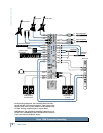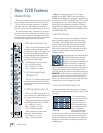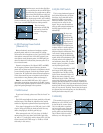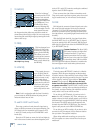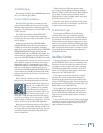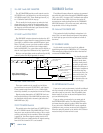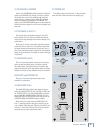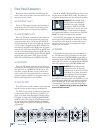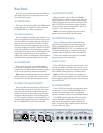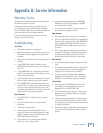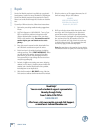
15
Owner’s Manual
Owner’s Manual
23. PHONES Knob
This controls the volume at the PHONES output, from
off (∞) to maximum gain (MAX).
24. LEFT/RIGHT Level Meters
The Onyx 1220’s peak meters are made up of two
columns of twelve LEDs, with three colors to indicate
different ranges of signal level, traffi c light style. They
range from –30 at the bottom, to 0 in the middle, to +20
(CLIP) at the top.
The 0 LED in the middle is labeled LEVEL SET
to show where the level should be when adjusting a
channel’s gain in the solo mode, as described in “Set the
Levels” on page 5.
If nothing is selected in the CONTROL ROOM/
PHONES SOURCE matrix (20) and no channels are
in SOLO, the meters won’t do anything. To display a
signal level, a source must be selected in the CONTROL
ROOM/PHONES SOURCE matrix, which feeds the
CONTROL ROOM (48) and PHONES (42) outputs. The
meters refl ect the program level of the selected source
prior to the CONTROL ROOM and PHONES level knobs.
The reason for this is because you want the meters to
refl ect what the engineer is listening to, and as we’ve
covered, the engineer is listening either to the CON-
TROL ROOM outputs or the PHONES outputs. The only
difference is that while the listening levels are con-
trolled by the CONTROL ROOM and PHONES knobs, the
meters indicated the SOURCE mix before those knobs,
giving you the real facts at all times, even if you’re not
listening at all.
When a channel is soloed, the meters change to re-
fl ect the level of that channel’s signal level, pre-fader.
You may already be an expert at the
world of “+4” (+4 dBu=1.23 V) and
“–10” (–10 dBV=0.32 V) operating
levels. What makes a mixer one or
the other is the relative 0 dB VU (or
0 VU) chosen for the meters. A “+4”
mixer, with +4 dBu pouring out the back will actually
read 0 VU on its meters. A “–10” mixer, with a –10 dBV
signal trickling out will read, you guessed it, 0 VU on its
meters. So when is 0 VU actually 0 dBu? Right now!
Mackie mixers show things as they really are. When 0
dBu (0.775 V) is at the outputs, it shows as 0 dB VU on
the meters. What could be easier? By the way, the most
wonderful thing about standards is that there are so
many to choose from.
Thanks to the Onyx 1220’s wide dynamic range,
you can get a good mix with peaks fl ashing anywhere
between –20 and +10 dB on the meters. Most amplifi ers
clip at about +10 dBu, and some recorders aren’t so
forgiving either. For best real-world results, try to keep
your peaks between “0” and “+7.”
Remember, audio meters are just tools to help assure
you that your levels are “in the ballpark.” You don’t have
to stare at them (unless you want to).
25. RUDE SOLO Light
This large green LED fl ashes on and off when a
channel’s solo is active, as an additional reminder
beyond the indicating LEDs next to each SOLO button.
If you work on a mixer that has a solo function with no
indicator lights and you happen to forget you’re in solo
mode, you can easily be tricked into thinking that some-
thing is wrong with your mixer. Hence, the RUDE SOLO
light. It’s especially handy at about 3 am when no sound
is coming out of your monitors but your multitrack is
playing back like mad.
Auxiliary Section
This section includes the AUX MASTERS (Sends) and
the AUX RETURNS. These can be a bit confusing to the
uninitiated, so here’s the whole idea behind aux sends
and returns: sends are outputs and returns are inputs.
AUX SENDs tap signals off the channels, via the AUX
knobs (13/14), mix these signals together, then send
them out the AUX SEND jacks (38).
These outputs are fed to the inputs of an external
processor like a reverb or digital delay. From there,
the outputs of this external device are fed back to the
mixer’s AUX RETURN jacks (39). Then these signals are
sent through the AUX RETURN level controls (28), and
fi nally delivered to the MAIN MIX (36).
So, the original “dry” signals go from the channels to
the MAIN MIX and the affected “wet” signals go from
the AUX RETURNS to the MAIN MIX, and once mixed
together, the dry and wet signals combine to create a
glorious sound!
They can also be used to provide another mix for stage
monitors, for example. In this case, the AUX RETURNS
aren’t used to return the signal. Instead, they can be
used as additional stereo inputs.




